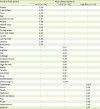1. Grieger JA, Grzeskowiak LE, Clifton VL. Preconception dietary patterns in human pregnancies are associated with preterm delivery. J Nutr. 2014; 144:1075–1080.


2. Procter SB, Campbell CG. Position of the academy of nutrition and dietetics: nutrition and lifestyle for a healthy pregnancy outcome. J Acad Nutr Diet. 2014; 114:1099–1103.


3. Kelly A, Kevany J, de Onis M, Shah PM. A WHO collaborative study of maternal anthropometry and pregnancy outcomes. Int J Gynaecol Obstet. 1996; 53:219–233.


4. Gilbert WM, Nesbitt TS, Danielsen B. Childbearing beyond age 40: pregnancy outcome in 24,032 cases. Obstet Gynecol. 1999; 93:9–14.


5. Kalhor M, Aj N, Alipour M, Eghdam Poor F. Comparison of pregnancy and delivery outcomes in teenage mothers and primiparas referring to Kowsar Teaching Hospital in Qazvin in 2012–2013. Razi J Med Sci. 2015; 21:27–38.
7. Fadaei B, Movahedi M, Akbari M, Ghasemi M, Jalalvand A. Effect of maternal age on pregnancy outcome. J Isfahan Med Sch. 2011; 29:855–860.
8. Ramakrishnan U, Grant F, Goldenberg T, Zongrone A, Martorell R. Effect of women's nutrition before and during early pregnancy on maternal and infant outcomes: a systematic review. Paediatr Perinat Epidemiol. 2012; 26:Suppl 1. 285–301.


9. Siega-Riz AM, Herrmann TS, Savitz DA, Thorp JM. Frequency of eating during pregnancy and its effect on preterm delivery. Am J Epidemiol. 2001; 153:647–652.


10. Herrmann TS, Siega-Riz AM, Hobel CJ, Aurora C, Dunkel-Schetter C. Prolonged periods without food intake during pregnancy increase risk for elevated maternal corticotropin-releasing hormone concentrations. Am J Obstet Gynecol. 2001; 185:403–412.


11. Cnattingius S, Villamor E, Johansson S, Edstedt Bonamy AK, Persson M, Wikström AK, Granath F. Maternal obesity and risk of preterm delivery. JAMA. 2013; 309:2362–2370.


13. Tucker KL. Dietary patterns, approaches, and multicultural perspective. Appl Physiol Nutr Metab. 2010; 35:211–218.

15. Englund-Ögge L, Brantsæter AL, Sengpiel V, Haugen M, Birgisdottir BE, Myhre R, Meltzer HM, Jacobsson B. Maternal dietary patterns and preterm delivery: results from large prospective cohort study. BMJ. 2014; 348:g1446.

16. Mishra GD, McNaughton SA, Bramwell GD, Wadsworth ME. Longitudinal changes in dietary patterns during adult life. Br J Nutr. 2006; 96:735–744.

17. Mishra GD, McNaughton SA, Ball K, Brown WJ, Giles GG, Dobson AJ. Major dietary patterns of young and middle aged women: results from a prospective Australian cohort study. Eur J Clin Nutr. 2010; 64:1125–1133.


18. Liu X, Du J, Wang G, Chen Z, Wang W, Xi Q. Effect of pre-pregnancy body mass index on adverse pregnancy outcome in north of China. Arch Gynecol Obstet. 2011; 283:65–70.


19. Vitoratos N, Deliveliotou A, Vlahos NF, Mastorakos G, Papadias K, Botsis D, Creatsas GK. Serum adiponectin during pregnancy and postpartum in women with gestational diabetes and normal controls. Gynecol Endocrinol. 2008; 24:614–619.


20. Ramirez VI, Miller E, Meireles CL, Gelfond J, Krummel DA, Powell TL. Adiponectin and IGFBP-1 in the development of gestational diabetes in obese mothers. BMJ Open Diabetes Res Care. 2014; 2:e000010.

21. Metzger BE, Coustan DR. Summary and recommendations of the Fourth International Workshop-Conference on Gestational Diabetes Mellitus. The Organizing Committee. Diabetes Care. 1998; 21:Suppl 2. B161–B167.
22. Willett WC. Nutritional epidemiology. In : Willett W, editor. Reproducibility and validity of food-frequency questionnaires. Oxford: Oxford University Press;1998. p. 101–107. DOI:
10.1093/acprof:oso/9780195122978.003.06.
23. Mirmiran P, Esfahani FH, Mehrabi Y, Hedayati M, Azizi F. Reliability and relative validity of an FFQ for nutrients in the Tehran Lipid and Glucose Study. Public Health Nutr. 2010; 13:654–662.

24. Ghazizahedi S, Nouri M, Norouzy A, Nemati M, Safarian M, Mohajeri SA, Esmaeely H, Shalaie N. Scientific: validity and reproducibility of Iranian food frequency questionnaire. Nutr Food Sci Res. 2014; 1:16.
25. American Diabetes Association. Gestational diabetes mellitus. Diabetes Care. 2002; 25:S94–S96.
26. World Health Organization. Iron deficiency anemia. assessment, prevention, and control: a guide for programme managers. Geneva: World Health Organization;2001. p. 47–62.
27. Centers for Disease Control (CDC). CDC criteria for anemia in children and childbearing-aged women. MMWR Morb Mortal Wkly Rep. 1989; 38:400–404.

28. Araujo Júnior E, Peixoto AB, Zamarian AC, Elito Júnior J, Tonni G. Macrosomia. Best Pract Res Clin Obstet Gynaecol. 2017; 38:83–96.

29. World Health Organization. Unicef. Low birthweight: country, regional and global estimates. New York (NY): Unicef;2004.
30. World Health Organization. Born too soon: the global action report on preterm birth. Geneva: World Health Organization;2012.
31. Aghapour B, Rashidi A, Dorosti-Motlagh A, Mehrabi Y. The association between major dietary patterns and overweight or obesity among Iranian adolescent girls. Iran J Nutr Sci Food Technol. 2013; 7:289–299.
32. Cheng C, Wei H, Xu C, Xie X, Jiang S, Peng J. Maternal soluble fiber diet during pregnancy changes the intestinal microbiota, improves growth performance, and reduces intestinal permeability in piglets. Appl Environ Microbiol. Forthcoming. 2018.

34. Zhang C, Schulze MB, Solomon CG, Hu FB. A prospective study of dietary patterns, meat intake and the risk of gestational diabetes mellitus. Diabetologia. 2006; 49:2604–2613.


36. Mohammadshahi M, Zakerzadeh M, Hashemi S, Haidari F. Dietary patterns in pregnancy and infants' anthropometric parameters at birth. J Hayat. 2013; 19:3–15.
37. Kim MK, Sasaki S, Sasazuki S, Tsugane S. Japan Public Health Center-based Prospective Study Group. Prospective study of three major dietary patterns and risk of gastric cancer in Japan. Int J Cancer. 2004; 110:435–442.


38. Scott-Pillai R, Spence D, Cardwell CR, Hunter A, Holmes VA. The impact of body mass index on maternal and neonatal outcomes: a retrospective study in a UK obstetric population, 2004–2011. BJOG. 2013; 120:932–939.











 PDF
PDF ePub
ePub Citation
Citation Print
Print



 XML Download
XML Download